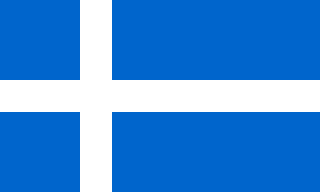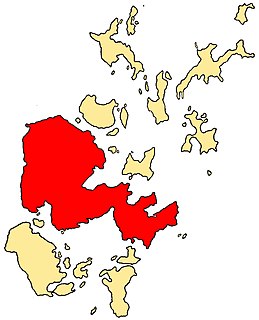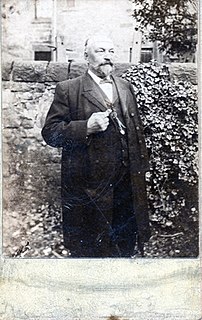
Shetland, also called the Shetland Islands and formerly Zetland, is a subarctic archipelago in the Northern Atlantic, between Great Britain, the Faroe Islands and Norway. It is the northernmost part of the United Kingdom, and lies 1° West of the Prime Meridian.

Kirkwall is the largest town in Orkney, an archipelago to the north of mainland Scotland.

Lerwick is the main town and port of the Shetland archipelago, Scotland. Shetland's only burgh, Lerwick had a population of about 7,000 residents in 2010.

Caledonian MacBrayne, usually shortened to CalMac, is the major operator of passenger and vehicle ferries, and ferry services, between the mainland of Scotland and 22 of the major islands on Scotland's west coast. Since 2006 the company's official name has been CalMac Ferries Ltd although it still operates as Caledonian MacBrayne. In 2006 it also became a subsidiary of holding company David MacBrayne, which is owned by the Scottish Government.

The Mainland, also known as Hrossey and Pomona, is the main island of Orkney, Scotland. Both of Orkney's burghs, Kirkwall and Stromness, lie on the island, which is also the heart of Orkney's ferry and air connections.

The Northern Isles are a pair of archipelagos off the north coast of mainland Scotland, comprising Orkney and Shetland. They are part of Scotland, as are the Hebrides. The climate is cool and temperate and much influenced by the surrounding seas. There are a total of 36 inhabited islands. The landscapes of the fertile agricultural islands of Orkney contrast with the more rugged Shetland islands to the north, where the economy is more dependent on fishing and on the oil wealth of the surrounding seas. Both island groups have a developing renewable energy industry. Both have a Pictish and Norse history. Both were part of the Kingdom of Norway until they were absorbed into the Kingdom of Scotland in the 15th century. They remained part of it until the 1707 formation of the Kingdom of Great Britain and the 1801 formation of the United Kingdom. And they both played a significant naval role during the world wars of the 20th century.

St Magnus Cathedral dominates the skyline of Kirkwall, the main town of Orkney, a group of islands off the north coast of mainland Scotland. It is the most northerly cathedral in the United Kingdom, a fine example of Romanesque architecture built for the bishops of Orkney when the islands were ruled by the Norse Earls of Orkney. It is owned not by the church, but by the burgh of Kirkwall as a result of an act of King James III of Scotland following Orkney's annexation by the Scottish Crown in 1468. It has its own dungeon.
Rognvald Brusason , son of Brusi Sigurdsson, was Earl of Orkney jointly with Thorfinn Sigurdsson from about 1037 onwards. His life is recorded in the Orkneyinga Saga.

NorthLink Ferries is an operator of passenger and vehicle ferries, as well as ferry services, between mainland Scotland and the Northern Isles of Orkney and Shetland. Since July 2012, it has been operated by international services company Serco.

P&O Scottish Ferries ran ferry services between the Scottish mainland and Orkney and Shetland from 1971 to 2002.

The Ve Skerries or Vee Skerries are a group of low skerries three miles (4.8 km) north west of Papa Stour, on the west coast of Shetland, Scotland. They define the southwest perimeter of St Magnus Bay.

Yell Sound is the strait running between Yell and Mainland, Shetland, Scotland. It is the boundary between the Mainland and the North Isles and it contains many small islands. Sullom Voe, on the shores of which is a substantial oil terminal, is an arm of Yell Sound.
SS St. Sunniva was one of the first purpose-built cruise ships. Converted into a ferry in 1908, she operated as the Lerwick mail steamer until 10 April 1930, when she ran aground off Shetland and was a complete loss.

MV Claymore was a car and passenger ferry built in 1978 for Caledonian MacBrayne. For ten years, she operated between Oban and the Outer Isles. Between October 2002 and March 2009, she was the Pentland Ferries relief vessel on the Short Sea Crossing to Orkney. Since March 2009, she has operated, as MV Sia, a RORO cable-laying and supply vessel.

MV Hebridean Princess is a cruise ship operated by Hebridean Island Cruises. She started life as the MacBrayne car ferry and Royal Mail Ship, initially RMS then MV Columba, based in Oban for the first 25 years of her life, carrying up to 600 passengers, and 50 cars, between the Scottish islands.

MV Hjaltland is a NorthLink Ferries vehicle and passenger ferry based in Aberdeen. She operates daily ferry services between mainland Scotland and the northern archipelagos of Orkney and Shetland.

MV Hrossey is a NorthLink Ferries vehicle and passenger ferry based in Aberdeen. With her sister ship, MV Hjaltland, she operates a daily ferry service between mainland Scotland and the northern archipelagos of Orkney and Shetland.

Robert Nisbet (1834–1917) was a Shetland sea captain. He was born on 15 October 1834 at Burravoe on the island of Yell, Shetland. He died on 3 May 1917 at Leith, Scotland.
SV Illeri was a Norwegian transport ship built in 1878 which operated until its wrecking on the Ve Skerries, Shetland on 9 May 1909.



















